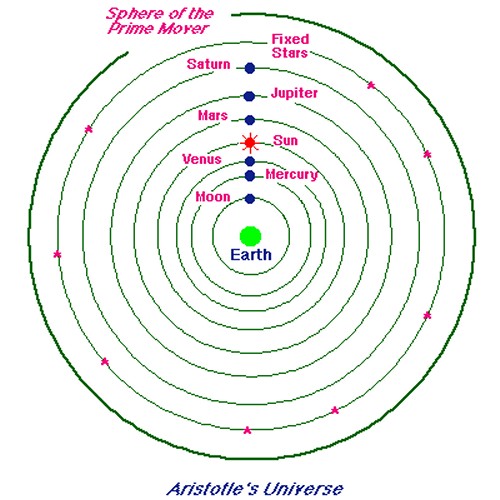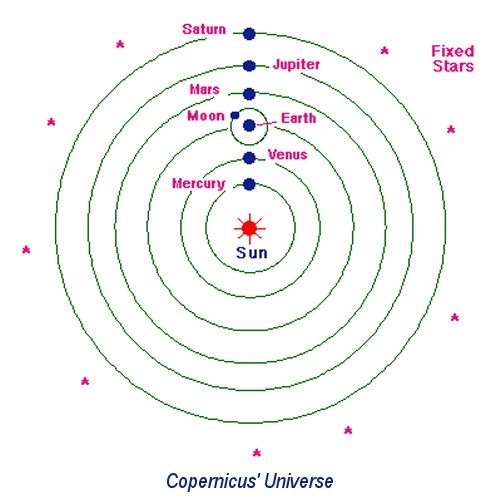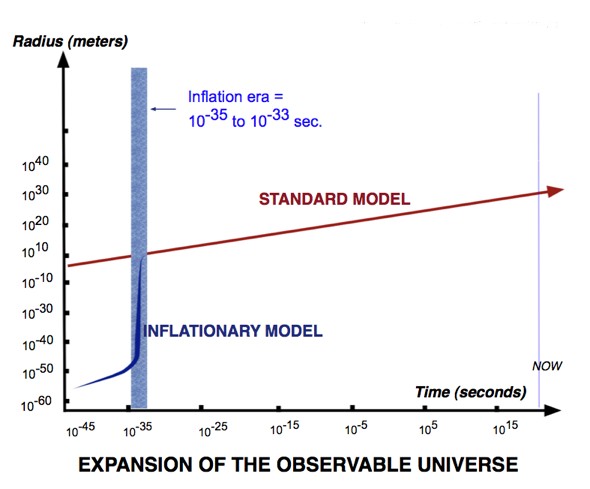Cosmological Theories Through History
"Cosmos" is just another word for
universe, and "cosmology" is the study of the origin, evolution and fate of the
universe. Some of the best minds in history - both philosophers and scientists - have applied themselves to an understanding of just what the
universe is and where it came from, suggesting in the process a bewildering variety of theories and ideas, from the Cosmic Egg to the
Big Bang and beyond. Here are some of the main ones, in approximate chronological order:
- Brahmanda (Cosmic Egg) Universe - The Hindu Rigveda, written in India around the 15th - 12th Century B.C., describes a cyclical or
oscillating universe in which a “cosmic egg”, or Brahmanda, containing the whole
universe (including the Sun, Moon, planets and all of space) expands out of a single concentrated point called a Bindu before subsequently collapsing again. The
universe cycles infinitely between expansion and total collapse.
- Anaxagorian Universe - The 5th Century B.C. Greek philosopher Anaxagoras believed that the original state of the cosmos was a primordial mixture of all its ingredients which existed in infinitesimally small fragments of themselves. This mixture was not entirely uniform, and some ingredients were present in higher concentrations than others, as well as varying from place to place. At some point in time, this mixture was set in motion by the action of “nous” (mind), and the whirling motion shifted and separated out the ingredients, ultimately producing the cosmos of separate material objects, all with different properties, that we see today.
- Atomist Universe - Later in the 5th Century B.C., the Greek philosophers Leucippus and Democritus founded the school of Atomism, which held that the
universe was composed of very small, indivisible and indestructible building blocks known as
atoms (from the Greek “atomos”, meaning “uncuttable”). All of reality and all the objects in the
universe are composed of different arrangements of these eternal
atoms and an infinite void, in which they form different combinations and shapes.

(
Click for a larger version)
Geocentric universe of Aristotle and Ptolemy
(Original Source N/A: cartage.org.lb/en/
themes/sciences/mainpage.htm)
|
|
|
- Aristotelian Universe - The Greek philosopher Aristotle, in the 4th Century B.C., established a geocentric
universe in which the fixed, spherical Earth is at the center, surrounded by concentric celestial spheres of planets and
stars. Although he believed the
universe to be finite in size, he stressed that it exists unchanged and static throughout eternity. Aristotle definitively established the four classical
elements of fire, air, earth and water, which were acted on by two forces,
gravity (the tendency of earth and water to sink) and levity (the tendency of air and fire to rise). He later added a fifth
element, aether, to describe the void that fills the
universe above the terrestrial sphere.
- Stoic Universe - The Stoic philosophers of ancient Greece (3rd Century B.C. and after) believed in a kind of island
universe in which a finite cosmos is surrounded by an infinite void (not dissimilar in principle to a
galaxy). They held that the cosmos is in a constant state of flux, and pulsates in size and periodically passes through upheavals and conflagrations. In the Stoic view, the
universe is like a giant living body, with its leading part being the
stars and the Sun, but in which all parts are interconnected, so that what happens in one place affects what happens elsewhere. They also held a cyclical view of history, in which the world was once pure fire and would become fire again (an idea borrowed from Heraclitus).
- Heliocentric Universe - The 3rd Century B.C. Greek astronomer and mathematician Aristarchus of Samos was the first to present an explicit argument for a heliocentric model of the Solar System, placing the Sun, not the Earth, at the center of the known
universe. He described the Earth as rotating daily on its axis and revolving annually about the Sun in a circular orbit, along with a sphere of fixed
stars. His ideas were generally rejected in favor of the geocentric theories of Aristotle and Ptolemy until they were successfully revived nearly 1800 years later by Copernicus. However, there were exceptions: Seleucus of Seleucia, who lived about a century after Aristarchus, supported his theories and used the tides to explain heliocentricity and the influence of the Moon; the Indian astronomer and mathematician Aryabhata described elliptical orbits around the Sun at the end of the 5th Century A.D.; as did the Muslim astronomer Ja'far ibn Muhammad Abu Ma'shar al-Balkhi in the 9th Century.
- Ptolemaic Universe - The 2nd Century A.D. Roman-Egyptian mathematician and astronomer Ptolemy (Claudius Ptolemaeus) described a geocentric model largely based on Aristotelian ideas, in which the planets and the rest of the
universe orbit about a stationary Earth in circular epicycles. In terms of longevity, it was perhaps the most successful cosmological model of all time. Modifications to the basic Ptolemaic system were suggested by the Islamic Maragha School in the 13th, 14th and 15th Centuries including the first accurate lunar model by Ibn al-Shatir, and the rejection of a stationary Earth in favor of a rotating Earth by Ali Qushji.
- Abrahamic Universe - Several medieval Christian, Muslim and Jewish scholars put forward the idea of a
universe which was finite in time. In the 6th Century A.D., the Christian philosopher John Philoponus of Alexandria argued against the ancient Greek notion of an infinite past, and was perhaps the first commentator to argue that the
universe is finite in time and therefore had a beginning. Early Muslim theologians such as Al-Kindi (9th Century) and Al-Ghazali (11th Century) offered logical arguments supporting a finite
universe, as did the 10th Century Jewish philosopher Saadia Gaon.
- Partially Heliocentric Universe - In the 15th and early 16th Century, Somayaji Nilakantha of the Kerala school of astronomy and mathematics in southern India developed a computational system for a partially heliocentric planetary model in which Mercury, Venus, Mars, Jupiter and Saturn orbited the Sun, which in turn orbited the Earth. This was very similar to the Tychonic system proposed by the Danish nobleman Tycho Brahe later in the 16th Century as a kind of hybrid of the Ptolemaic and Copernican models.

(
Click for a larger version)
Heliocentric universe of Copernicus
(Original Source N/A: cartage.org.lb/en/
themes/sciences/mainpage.htm)
|
|
|
- Copernican Universe - In 1543, the Polish astronomer and polymath Nicolaus Copernicus adapted the geocentric Maragha model of Ibn al-Shatir to meet the requirements of the ancient heliocentric
universe of Aristarchus. His publication of a scientific theory of heliocentrism, demonstrating that the motions of celestial objects can be explained without putting the Earth at rest in the center of the
universe, stimulated further scientific investigations and became a landmark in the history of modern science, sometimes known as the Copernican Revolution. His
Copernican Principle (that the Earth is not in a central, specially favored position) and its implication that celestial bodies obey physical laws identical to those on Earth, first established cosmology as a science rather than a branch of metaphysics. In 1576, the English astronomer Thomas Digges popularized Copernicus’ ideas and also extended them by positing the existence of a multitude of
stars extending to infinity, rather than just Copernicus’ narrow band of fixed
stars. The Italian philosopher Giordano Bruno took the
Copernican Principle a stage further in 1584 by suggesting that even the Solar System is not the center of the
universe, but rather a relatively insignificant
star system among an infinite multitude of others. In 1605, Johannes Kepler made further refinements by finally abandoning the classical assumption of circular orbits in favor of elliptical orbits which could explain the strange apparent movements of the planets. Galileo's controversial support of Copernicus' heliocentric model in the early 17th Century was denounced by the Inquisition but nevertheless helped to popularize the idea.
- Cartesian Vortex Universe - In the mid-17th Century, the French philosopher René Descartes outlined a model of the
universe with many of the characteristics of Newton’s later static, infinite
universe. But, according to Descartes, the vacuum of space was not empty at all, but was filled with
matter that swirled around in large and small vortices. His model involved a system of huge swirling whirlpools of ethereal or fine
matter, producing what would later be called
gravitational effects.
- Static (or Newtonian) Universe - In 1687, Sir Isaac Newton published his “Principia”, which described, among other things, a static, steady state, infinite
universe which even
Einstein, in the early 20th Century, took as a given (at least until events proved otherwise). In Newton’s
universe,
matter on the large scale is uniformly distributed, and the
universe is gravitationally balanced but essentially unstable.
- Hierarchical Universe and the Nebular Hypothesis - Although still generally based on a Newtonian static
universe, the
matter in a hierarchical
universe is clustered on even larger scales of hierarchy, and is endlessly being recycled. It was first proposed in 1734 by the Swedish scientist and philosopher Emanuel Swedenborg, and developed further (independently) by Thomas Wright (1750), Immanuel Kant (1755) and Johann Heinrich Lambert (1761), and a similar model was proposed in 1796 by the Frenchman Pierre-Simon Laplace.
- Einsteinian Universe - The model of the
universe assumed by
Albert Einstein in his groundbreaking theory of
gravity in the early 20th Century was not dissimilar to Newton’s in that it was a static, dynamically stable
universe which was neither expanding or contracting. However, he had to add in a “
cosmological constant” to his
general relativity equations to counteract the dynamical effects of
gravity which would otherwise have caused the
universe to collapse in on itself (although he later abandoned that part of his theory when
Edwin Hubble definitively showed in 1929 that the
universe was not in fact static).
- Big Bang Model of the Universe - After
Hubble’s demonstration of the continuously
expanding universe in 1929 (and especially after the discovery of
cosmic microwave background radiation by Arno Penzias and Robert Wilson in 1965), some version of the
Big Bang theory has generally been the mainstream scientific view. The theory describes the
universe as originating in an infinitely tiny, infinitely dense point (or
singularity) between 13 and 14 billion years ago, from where it has been expanding ever since. The essential statement of the theory is usually attributed to the Belgian Roman Catholic priest and physicist
Georges Lemaître in 1927 (even before
Hubble’s corroborating evidence), although a similar theory had been proposed, although not pursued, 1922 by the Russian
Alexander Friedmann in 1922.
Friedmann actually developed two models of an expanding
universe based on
Einstein’s
general relativity equations, one with positive curvature or spherical space, and one with negative curvature or hyperbolic space.
- Oscillating Universe - This was
Einstein’s favored model after he rejected his own original model in the 1930s. The
oscillating universe followed from
Alexander Friedmann’s model of an expanding
universe based on the
general relativity equations for a
universe with positive curvature (spherical space), which results in the
universe expanding for a time and then contracting due to the pull of its
gravity, in a perpetual cycle of
Big Bang followed by
Big Crunch. Time is thus endless and beginningless, and the beginning-of-time paradox is avoided.
- Steady State Universe - This non-standard cosmology (i.e. opposed to the standard
Big Bang model) has occurred in various versions since the
Big Bang theory was generally adopted by the scientific community. A popular variant of the
steady state universe was proposed in 1948 by the English astronomer
Fred Hoyle and the and Austrians Thomas Gold and Hermann Bondi. It predicted a
universe that expanded but did not change its
density, with
matter being inserted into the
universe as it expanded in order to maintain a constant
density. Despite its drawbacks, this was quite a popular idea until the discovery of the
cosmic microwave background radiation in 1965 which supported the
Big Bang model.
- Inflationary (or Inflating) Universe - In 1980, the American physicist
Alan Guth proposed a model of the
universe based on the
Big Bang, but incorporating a short, early period of exponential
cosmic inflation in order to solve the horizon and flatness problems of the standard
Big Bang model. Another variation of the inflationary
universe is the cyclic model developed by Paul Steinhardt and Neil Turok in 2002 using state-of-the-art M-theory,
superstring theory and brane cosmology, which involves an inflationary
universe expanding and contracting in cycles.
- Multiverse - The Russian-American physicist Andrei Linde developed the inflationary universe idea further in 1983 with his chaotic
inflation theory (or eternal
inflation), which sees our
universe as just one of many “bubbles” that grew as part of a
multiverse owing to a vacuum that had not decayed to its ground state. The American physicists Hugh Everett III and Bryce DeWitt had initially developed and popularized their “many worlds” formulation of the
multiverse in the 1960s and 1970s. Alternative versions have also been developed where our observable
universe is just one tiny organized part of an infinitely big cosmos which is largely in a state of chaos, or where our organized
universe is just one temporary episode in an infinite sequence of largely chaotic and unorganized arrangements.
|




